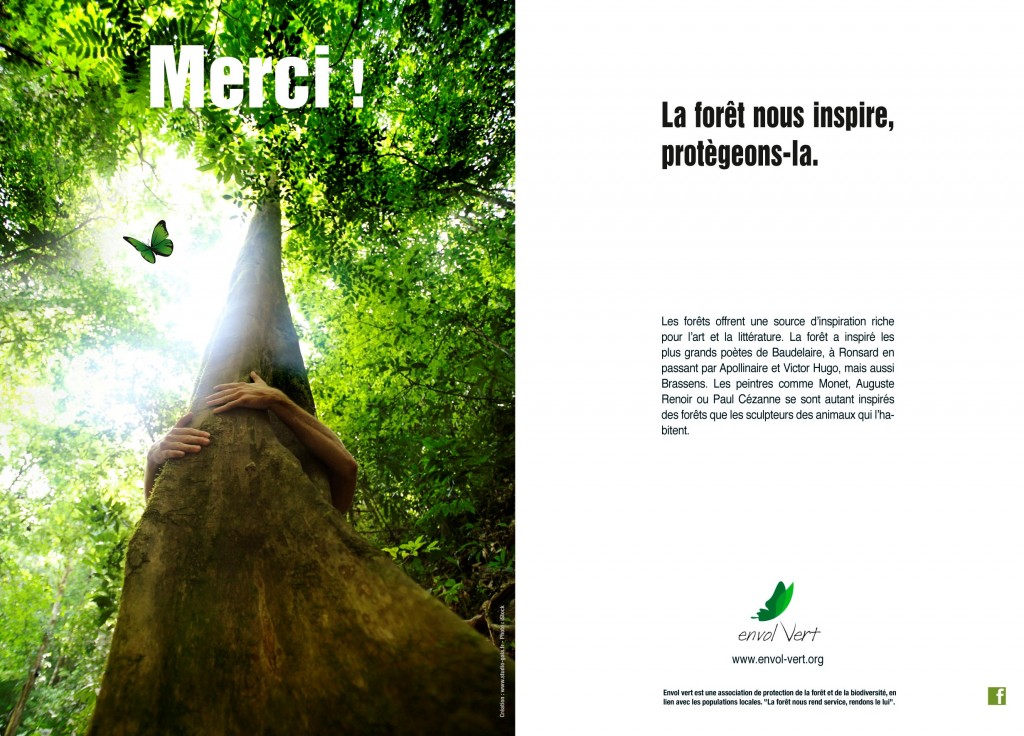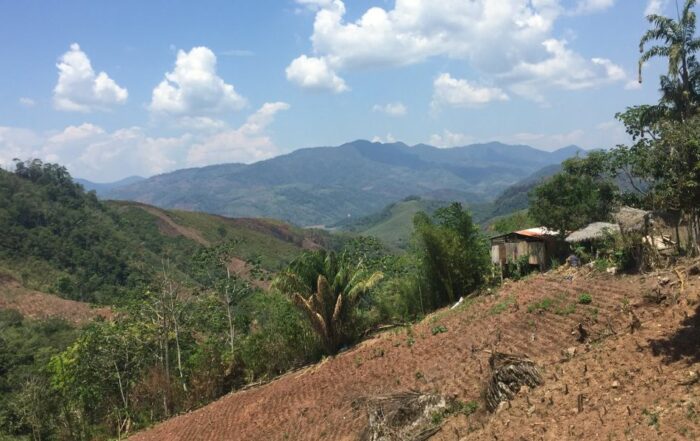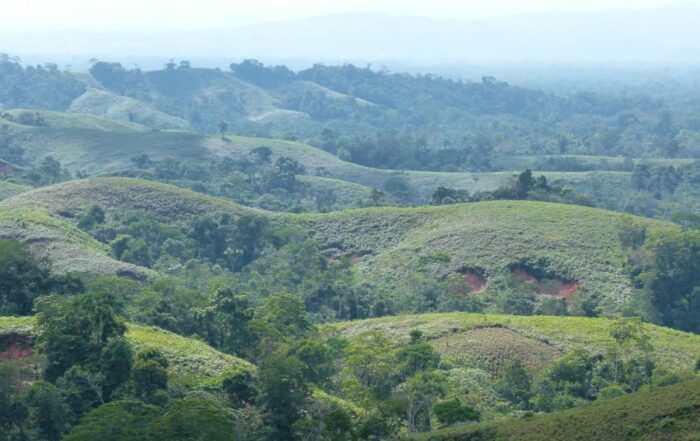As for sculptors inspired by nature, the Grand Palais in Paris recently dedicated an entire exhibition to their works, named Animal Beauty. The exhibition showed the works of several sculptors who had focused on the animals of the forest: The representative (a stag) by Gloria Friedmann, Pompon’s Orangutan and The Tiger and the Gharial crocodile by the romantic sculptor Antoine-Louis Barye.
Thank You! The forest can inspire us,
Let’s look after it!
The forest offer a rich source of inspiration for both the visual arts and literature. The forest has inspired some of history’s greatest poets: from Baudelaire to Ronsard, to Apollinaire to Victor Hugo – and even Georges Brassens! Celebrated impressionist painters such as Monet, Auguste Renoir and Paul Cézanne have also taken inspiration from the forest and the animals living there. *
Forests offer a source of inspiration…
![[FORET TROPICALE]Castano©D.Tarrier](http://envol-vert.org/wp-content/uploads/2012/08/FORET-TROPICALECastano©D.Tarrier-225x300.jpg) Forests act as a rich source of inspiration, notably in art, folklore, national symbols and architecture. Our forests have therefore inspired many of us: on the flags of around 10 countries –such as that of Lebanon, bearing its cedar tree-; in the works of celebrated poets such as Charles Baudelaire, who wrote that ‘nature is a temple…’; or Joachim du Bellay, who asked us ‘Who has ever seen a great, withered oak’… Indeed, as Georges Brassens’ much-loved tune ‘At the foot of my tree’ goes to show, the magic of forests can even be found in song….
Forests act as a rich source of inspiration, notably in art, folklore, national symbols and architecture. Our forests have therefore inspired many of us: on the flags of around 10 countries –such as that of Lebanon, bearing its cedar tree-; in the works of celebrated poets such as Charles Baudelaire, who wrote that ‘nature is a temple…’; or Joachim du Bellay, who asked us ‘Who has ever seen a great, withered oak’… Indeed, as Georges Brassens’ much-loved tune ‘At the foot of my tree’ goes to show, the magic of forests can even be found in song….
Forests also have an endless power to influence the creativity of painters and sculptors throughout history… Sumptuous images depiciting the life of the forest can be found in the works of Monet (Oak, in the forest of Fontainbleau) and Auguste Renoir (Jules le Coeur and his dogs in the forest of Fontainbleau).
As for sculptors inspired by nature, the Grand Palais in Paris recently dedicated an entire exhibition to their works, named Animal Beauty. The exhibition showed the works of several sculptors who had focused on the animals of the forest: The representative (a stag) by Gloria Friedmann, Pompon’s Orangutan and The Tiger and the Gharial crocodile by the romantic sculptor Antoine-Louis Barye.
Forests can be a space for relaxtion – or for learning through play
![[FORET TROPICALE]arbre©D.Tarrier](http://envol-vert.org/wp-content/uploads/2012/08/FORET-TROPICALEarbre©D.Tarrier-200x300.jpg) Countless books have been written about the forest: from novels to those which teach us to recognise different species of trees, or invite us to discover the delicious recipes which can be made using forest produce (do any of wild mushroom tapenade, nettle Quiche or elderflower do’nuts wet your appetite?)
Countless books have been written about the forest: from novels to those which teach us to recognise different species of trees, or invite us to discover the delicious recipes which can be made using forest produce (do any of wild mushroom tapenade, nettle Quiche or elderflower do’nuts wet your appetite?)
And what about the playful stories and lessons for children such as fairytles, nursery rhymes and other songs, many of which refer to the magic and mystery of the forest and the creatures who live there? Teddy Bears’ Picnic, Tom Thumb, Goldilocks and the three bears, Little Red Riding Hood or the brothers’ Grimm’s Hansel and Gretel….
Many well-known films have celebrated the forest, while providing a great story for their audience. For example, in Hayao Miyazaki’s critically acclaimed film Princess Mononoki, the main subject of the story is that of protecting the soul of the forest, as is the case in Jame’s Cameron more recent box office hit Avatar. Lots of cartoons have also gone green and looked to the forest for ideas, such as The Forest by Tiburce Oger-Vincent Perz, The Opal Forests by Arleston Scotch and Philippe Pellet and Seraphine and the forest creatures by David Chauvel. Going back even further, not to forget the mythical French duo Asterix and Obelix and their magic potion, or Panoramix’s tree druid….
Many well-known films have celebrated the forest, while providing a great story for their audience. For example, in Hayao Miyazaki’s critically acclaimed film Princess Mononoki, the main subject of the story is that of protecting the soul of the forest, as is the case in Jame’s Cameron more recent box office hit Avatar. Lots of cartoons have also gone green and looked to the forest for ideas, such as The Forest by Tiburce Oger-Vincent Perz, The Opal Forests by Arleston Scotch and Philippe Pellet and Seraphine and the forest creatures by David Chauvel. Going back even further, not to forget the mythical French duo Asterix and Obelix and their magic potion, or Panoramix’s tree druid….
Les Forests, the source of artistic and national wealth…
![[FORET TROPICALE]IMG_5026©D.Tarrier](http://envol-vert.org/wp-content/uploads/2012/08/FORET-TROPICALEIMG_5026©D.Tarrier-225x300.jpg) Many of us appreciate the beauty of forest landscapes, as can often be seen in our choices of where to build our homes or how we spend our leisure time-on pursuits such as visiting national parks, for instance. And who has never at least thought about taking a holiday in the woods – if not to meditate then at least to switch off and relax? The forest carries great cultural importance for us all…
Many of us appreciate the beauty of forest landscapes, as can often be seen in our choices of where to build our homes or how we spend our leisure time-on pursuits such as visiting national parks, for instance. And who has never at least thought about taking a holiday in the woods – if not to meditate then at least to switch off and relax? The forest carries great cultural importance for us all…
A lot of societies attach great importance to areas of historical significance, known as ‘cultural landscapes’, or sites of cultural significance. The Brocéliande forest, for example, is one of the key mythical and historical sites of French heritage. Or across different communities in Africa, you can see the recurring symbolic importance of the baobab tree.
The rich cultural wealth of the forest can also have an educational value: Indeed, nature walks in the woods to discover animals and plants, wildlife clubs and nature painting all emphasis the forest’s position at the heart of the education system.
The failure to recognise the cultural value of our forests when we try to calculate their economic worth has left room for the growth of activities which harm our natural environment. We must in fact do more to look after our forests, in part because they are of great economic value, especially as a source of revenue to the tourist industry. In 2007, rainforests were estimated as a source of 381 to 1171$ income for the tourism sector. Ecotourism is one of the fastest-growing sectors of global tourism, with a rate of 20% growth year on year (UN, 2011).
As for sculptors inspired by nature, the Grand Palais in Paris recently dedicated an entire exhibition to their works, named Animal Beauty. The exhibition showed the works of several sculptors who had focused on the animals of the forest: The representative (a stag) by Gloria Friedmann, Pompon’s Orangutan and The Tiger and the Gharial crocodile by the romantic sculptor Antoine-Louis Barye.
Thank You! The forest can inspire us,
Let’s look after it!
The forest offer a rich source of inspiration for both the visual arts and literature. The forest has inspired some of history’s greatest poets: from Baudelaire to Ronsard, to Apollinaire to Victor Hugo – and even Georges Brassens! Celebrated impressionist painters such as Monet, Auguste Renoir and Paul Cézanne have also taken inspiration from the forest and the animals living there. *
Forests offer a source of inspiration…
![[FORET TROPICALE]Castano©D.Tarrier](http://envol-vert.org/wp-content/uploads/2012/08/FORET-TROPICALECastano©D.Tarrier-225x300.jpg) Forests act as a rich source of inspiration, notably in art, folklore, national symbols and architecture. Our forests have therefore inspired many of us: on the flags of around 10 countries –such as that of Lebanon, bearing its cedar tree-; in the works of celebrated poets such as Charles Baudelaire, who wrote that ‘nature is a temple…’; or Joachim du Bellay, who asked us ‘Who has ever seen a great, withered oak’… Indeed, as Georges Brassens’ much-loved tune ‘At the foot of my tree’ goes to show, the magic of forests can even be found in song….
Forests act as a rich source of inspiration, notably in art, folklore, national symbols and architecture. Our forests have therefore inspired many of us: on the flags of around 10 countries –such as that of Lebanon, bearing its cedar tree-; in the works of celebrated poets such as Charles Baudelaire, who wrote that ‘nature is a temple…’; or Joachim du Bellay, who asked us ‘Who has ever seen a great, withered oak’… Indeed, as Georges Brassens’ much-loved tune ‘At the foot of my tree’ goes to show, the magic of forests can even be found in song….
Forests also have an endless power to influence the creativity of painters and sculptors throughout history… Sumptuous images depiciting the life of the forest can be found in the works of Monet (Oak, in the forest of Fontainbleau) and Auguste Renoir (Jules le Coeur and his dogs in the forest of Fontainbleau).
As for sculptors inspired by nature, the Grand Palais in Paris recently dedicated an entire exhibition to their works, named Animal Beauty. The exhibition showed the works of several sculptors who had focused on the animals of the forest: The representative (a stag) by Gloria Friedmann, Pompon’s Orangutan and The Tiger and the Gharial crocodile by the romantic sculptor Antoine-Louis Barye.
Forests can be a space for relaxtion – or for learning through play
![[FORET TROPICALE]arbre©D.Tarrier](http://envol-vert.org/wp-content/uploads/2012/08/FORET-TROPICALEarbre©D.Tarrier-200x300.jpg) Countless books have been written about the forest: from novels to those which teach us to recognise different species of trees, or invite us to discover the delicious recipes which can be made using forest produce (do any of wild mushroom tapenade, nettle Quiche or elderflower do’nuts wet your appetite?)
Countless books have been written about the forest: from novels to those which teach us to recognise different species of trees, or invite us to discover the delicious recipes which can be made using forest produce (do any of wild mushroom tapenade, nettle Quiche or elderflower do’nuts wet your appetite?)
And what about the playful stories and lessons for children such as fairytles, nursery rhymes and other songs, many of which refer to the magic and mystery of the forest and the creatures who live there? Teddy Bears’ Picnic, Tom Thumb, Goldilocks and the three bears, Little Red Riding Hood or the brothers’ Grimm’s Hansel and Gretel….
Many well-known films have celebrated the forest, while providing a great story for their audience. For example, in Hayao Miyazaki’s critically acclaimed film Princess Mononoki, the main subject of the story is that of protecting the soul of the forest, as is the case in Jame’s Cameron more recent box office hit Avatar. Lots of cartoons have also gone green and looked to the forest for ideas, such as The Forest by Tiburce Oger-Vincent Perz, The Opal Forests by Arleston Scotch and Philippe Pellet and Seraphine and the forest creatures by David Chauvel. Going back even further, not to forget the mythical French duo Asterix and Obelix and their magic potion, or Panoramix’s tree druid….
Many well-known films have celebrated the forest, while providing a great story for their audience. For example, in Hayao Miyazaki’s critically acclaimed film Princess Mononoki, the main subject of the story is that of protecting the soul of the forest, as is the case in Jame’s Cameron more recent box office hit Avatar. Lots of cartoons have also gone green and looked to the forest for ideas, such as The Forest by Tiburce Oger-Vincent Perz, The Opal Forests by Arleston Scotch and Philippe Pellet and Seraphine and the forest creatures by David Chauvel. Going back even further, not to forget the mythical French duo Asterix and Obelix and their magic potion, or Panoramix’s tree druid….
Les Forests, the source of artistic and national wealth…
![[FORET TROPICALE]IMG_5026©D.Tarrier](http://envol-vert.org/wp-content/uploads/2012/08/FORET-TROPICALEIMG_5026©D.Tarrier-225x300.jpg) Many of us appreciate the beauty of forest landscapes, as can often be seen in our choices of where to build our homes or how we spend our leisure time-on pursuits such as visiting national parks, for instance. And who has never at least thought about taking a holiday in the woods – if not to meditate then at least to switch off and relax? The forest carries great cultural importance for us all…
Many of us appreciate the beauty of forest landscapes, as can often be seen in our choices of where to build our homes or how we spend our leisure time-on pursuits such as visiting national parks, for instance. And who has never at least thought about taking a holiday in the woods – if not to meditate then at least to switch off and relax? The forest carries great cultural importance for us all…
A lot of societies attach great importance to areas of historical significance, known as ‘cultural landscapes’, or sites of cultural significance. The Brocéliande forest, for example, is one of the key mythical and historical sites of French heritage. Or across different communities in Africa, you can see the recurring symbolic importance of the baobab tree.
The rich cultural wealth of the forest can also have an educational value: Indeed, nature walks in the woods to discover animals and plants, wildlife clubs and nature painting all emphasis the forest’s position at the heart of the education system.
The failure to recognise the cultural value of our forests when we try to calculate their economic worth has left room for the growth of activities which harm our natural environment. We must in fact do more to look after our forests, in part because they are of great economic value, especially as a source of revenue to the tourist industry. In 2007, rainforests were estimated as a source of 381 to 1171$ income for the tourism sector. Ecotourism is one of the fastest-growing sectors of global tourism, with a rate of 20% growth year on year (UN, 2011).








